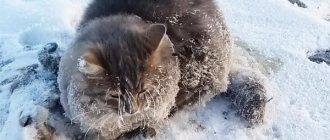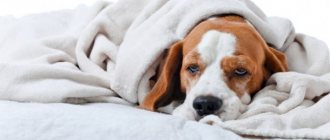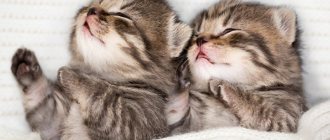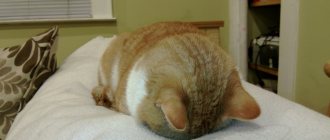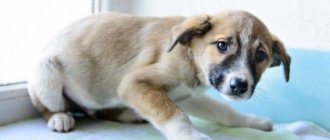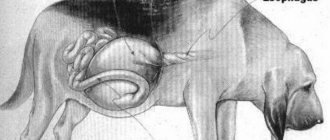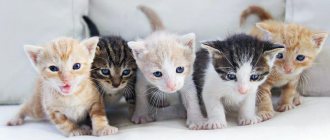Sometimes inexperienced owners are surprised: why does a cat twitch in its sleep? There is no need to panic, for animals it is as natural as for a person to talk in a dream. One cat twitches more often in its sleep, another almost never, this is very individual among cats.
Sometimes, inexperienced owners are surprised that the kitten twitches in its sleep, and may even make strange sounds: sometimes purr, sometimes “cry out.” This behavior during sleep is quite natural for animals; this is not at all an indication that the pet is sick with something.
Like people, our smaller brothers have certain sleep phases. At the same time, in cats, the duration of “deep” sleep is about a quarter of the total time spent in blissful slumber. And yet, why does this happen, why does a cat twitch in its sleep?
It may seem like cats are terrible lazy people, because they sleep most of the day, but in fact, this is not entirely true. What looks like sleep is often simply a state of relaxation, with the animal in control of everything that happens around it. Have you probably noticed that a “sleeping” cat opens one eye slightly as soon as some movement occurs?
So, when a cat decides to take a nap, she curls up, gets comfortable, and relaxes all her muscles. The shallow sleep phase begins, and after about 10-30 minutes it gives way to deep sleep.
Should you worry if your cat twitches violently in her sleep?
Light twitching during sleep is normal for a cat. Movements of the paws, tail and mouth indicate the onset of REM sleep. Most often, such activity occurs in young individuals. If the animal is more than two years old, twitching during sleep can be a sign of nervousness, as well as hidden or overt aggression. The cat may have been stressed during the day.
You should consult a specialist if your animal's twitching resembles convulsions. If in doubt, you need to wake up your pet. If the cat is healthy, it will be cheerful within 10-15 seconds. Difficulty breathing, lethargy and impaired swallowing reflex are alarming signs indicating the presence of pathology. The cause of restless sleep can be diseases such as:
- poisoning with food, chemicals, gases;
- dehydration;
- hypothermia or heatstroke;
- pathologies of the cardiovascular system;
- diabetes;
- dysfunction of the thyroid gland;
- respiratory tract damage.
If your pet doesn't wake up at all, it's likely having a seizure and you should call the vet immediately. Convulsions indicate a disturbance in the central nervous system, so they should not be ignored. The risk group includes cats that are expecting a litter and have recently given birth. Postpartum preeclampsia, accompanied by tremors and hypoglycemia, is a dangerous condition that can lead to coma and death of the animal.
A cat may twitch in its sleep either due to illness or for natural reasons. If the animal's health is of concern, you need to carefully wake it up to make sure everything is in order. If the pet cannot recover, it needs urgent medical attention.
Reasons why a cat trembles
Tremor or trembling in a pet is not always a sign of illness
. If a cat is trembling, then it is almost impossible not to notice this state of the animal. There are several main reasons that can cause a pet to tremble in apparent absolute health:
- an animal's reaction to an external stimulus represented by cold
. This reason is the most harmless, but can cause a number of quite serious consequences, including severe hypothermia of a pet. It is especially important to control the temperature in the room when keeping hairless breeds and cats with short hair. In cool weather, it is necessary to reduce walks with the animal to a minimum or completely eliminate its stay on the street; - an animal's reaction to severe fright or any stressful situation
. Quite often, this situation arises when there is a sudden change in diet, the appearance of strangers or unfamiliar animals in the house, as well as when being transported to a new place of residence. In this case, it is enough to eliminate all factors that provoke trembling as quickly as possible and calm the pet; - reaction to a joyful event
. Trembling in an animal can also cause quite positive emotions, including joy from the appearance of the owner or pleasure from games, affection and receiving favorite foods; - reaction to sexual arousal
. The appearance of fairly distinct trembling can be caused by a state of sexual arousal in a cat or a cat in heat. In almost all representatives of the cat family, all senses are very characteristically heightened and behavioral characteristics change greatly during the period of sexual arousal, therefore, it is advisable to sterilize or castrate animals not intended for breeding; - natural processes
. Actively occurring in the body of a sleeping pet, they can also be accompanied by trembling of the body and limbs.
Important!
Particular attention is required to frequent, quite strong tremors of the body and limbs, which occur in a pet regularly and for no apparent reason.
In this case, it is necessary to deliver the cat to a veterinary institution as quickly as possible, where a full range of basic, most informative diagnostic measures will be carried out aimed at identifying the cause of the pathological condition.
Health problems
If the movements are more like convulsions, then we can assume:
- Dehydration. Has a negative effect on the central nervous system. May cause involuntary muscle contractions.
- Poisoning. There are poisons that primarily affect the central nervous system. Even the ingestion of ordinary household chemicals into the body can be accompanied by a convulsive syndrome.
- Heatstroke, hypothermia, change of environment. A living creature will tremble if it has been in the cold for a long time and then finds itself in the warmth. Heatstroke and hypothermia can cause seizures.
- Infection. High body temperature is sometimes accompanied by convulsive syndrome.
Only a doctor can exclude the disease. If in doubt, it is better to consult a specialist.
Various movements can be attributed to twitching. Some of them are natural, others are not entirely, but the cat’s condition does not require correction, but others should prompt you to call the veterinarian. You should be concerned if your pet has some other strange manifestations and it takes a long time to come to its senses after suddenly waking up.
You can look at resting cats forever. The sweetest creatures become even more touching at such moments. However, during long-term observation, one strange feature can be noticed: the pet periodically moves its paws and tail. To understand whether this is normal, you need to understand why the kitten twitches when it sleeps. Transition to sleep Trembling at the very beginning of the sleep cycle - [...]
When twitching is normal
The question that most often arises is: why do you twitch when you fall asleep? The answer may be so-called physiological or benign myoclonus. Sometimes, when falling asleep, a person imagines that he is flying or falling into a hole. A sharp and strong relaxation of muscles is not always correctly perceived by our brain.
After all, absolute relaxation is death. So our brain transmits a signal to check whether the body is alive. The impulse rushes to the muscles, “revitalizing” the body and providing a tremor, which is a kind of signal about successful activity. This is why people twitch during sleep. Therefore, benign myoclonus is often observed in children and those people who fall asleep very quickly and without problems.
Phenomena that do not require intervention also include myoclonus in children and infants. Physiologists say that the sleep phases of babies are not similar to those of adults. And if for parents the deep sleep phase lasts 2-3 hours, then for their child it can only be an hour, alternating with shallow sleep. When transitioning from one phase to another, the baby begins to twitch and frighten the parents. Although there is no need to worry at all.
Health problems
If the movements are more like convulsions, then we can assume:
- Dehydration. Has a negative effect on the central nervous system. May cause involuntary muscle contractions.
- Poisoning. There are poisons that primarily affect the central nervous system. Even the ingestion of ordinary household chemicals into the body can be accompanied by a convulsive syndrome.
- Heatstroke, hypothermia, change of environment. A living creature will tremble if it has been in the cold for a long time and then finds itself in the warmth. Heatstroke and hypothermia can cause seizures.
- Infection. High body temperature is sometimes accompanied by convulsive syndrome.
Only a doctor can exclude the disease. If in doubt, it is better to consult a specialist.
Various movements can be attributed to twitching. Some of them are natural, others are not entirely, but the cat’s condition does not require correction, but others should prompt you to call the veterinarian. You should be concerned if your pet has some other strange manifestations and it takes a long time to come to its senses after suddenly waking up.
Light twitching
According to available data and statistics, most cats regularly experience small twitches while sleeping. Some experts believe they may be similar to what people experience during REM eye movement sleep. During rapid eye movement, people dream and experience a deep sense of pleasure in sleep. Those little twitches your kitten or cat makes could be simple movements they make while chasing a mouse or playing with other cats in their dreams.
Cat dreams
The world of dreams is like an otherworldly universe with its own laws and characteristics. Scientists have long established that animals dream like people, experiencing vivid and dynamic pictures. It is noteworthy that cats made a great contribution to the study of sleep, becoming test subjects in a number of experiments. The purpose of the research was to prove the theory that during the dreaming phase of sleep, people and animals with an intact brain are affected by atonia (lack of muscle tone), which blocks active movements.
Sleep Features
- Experts constantly study the behavior of furry animals, so they made conclusions regarding the sleep phases of cats. The first stage includes sleep of a superficial type, which is comparable to dozing. The animal controls its actions because the body does not relax completely. The pet is aware of what is happening around it and can stand up or open its eyes at any time.
- The second phase includes slow-moving sleep. It is characterized by relaxation of muscle fibers, a decrease in blood circulation, and a slowdown in heart rate and breathing. The individual may open its eyes slightly, as if fighting sleep, then close them again. Everything is done very slowly.
- And finally, the final phase, otherwise called REM sleep. As a rule, it takes no more than 7 minutes. Against this background, breathing changes, becoming intense at first, then slow and deep, then fast again. The heart is also unstable and may pound or be at rest. Usually the pressure rises, the eyes move, and sometimes the animal makes sharp twitches of its paws, ears, whiskers or tail.
- Studies have been carried out, during which it was possible to find out that it is the last stage that is the period when the pet dreams. The dream is filled with emotions, it turns out to be quite spectacular, and accordingly, the pet reacts to it. The phases are constantly changing and appear one after the other, so the behavior of your furry friend looks different.
The importance of REM sleep in kittens
Kittens are able to dream while still inside the mother cat. Moreover, REM sleep provides neural stimulation, which contributes to the normal development of the brain and the entire nervous system of the embryo. The REM phase is extremely important for newborns and growing animals. Young animals experience dreams especially vividly. Kitty:
- can move its paws;
- beat the tail on the floor;
- roll over from side to side;
- move your ears and cheek muscles;
- breathe rapidly and meow.
Especially often, such violent reactions appear after outdoor games, stress or hunting experience. Running and tired, the baby may fall asleep in an unnatural position with his eyes half-open, which also should not cause concern. Firstly, kittens are like human babies and relax in their sleep without feeling discomfort, and secondly, the presence of a third eyelid in the corner of the eye helps protect the eyeball from drying out.
Features of the nervous system in kittens. The nervous system is formed simultaneously with the growth of the body, so unusual motor activity in kittens in the REM phase is completely normal.
If in adult animals the duration of REM sleep is 15-20 minutes, followed by a longer phase of slow-wave sleep, then in kittens up to six months the REM phase takes up 80% of the total rest time.
If the owner noted that the growing furry pet began to sleep more calmly and practically does not flinch in its sleep, then we can talk about the animal growing up and strengthening the nervous system. The period of stabilization of nervous functions is very individual and is determined by many factors, such as:
- Breed affiliation . In outbred cats, which generally mature faster, psychological maturation begins by 12 months, and representatives of large breeds, growing up to 2-2.5 years, demonstrate elements of childish behavior for quite a long time.
- Character . Temperamental and easily excitable animals require more time for the development of nervous processes than balanced and calm phlegmatic animals.
- Personal negative experiences and traumas . Stress can cause serious damage to the psyche. It has been proven that animals that have experienced fear and pain can return to this episode in their sleep, experiencing real nightmares.
Factors
- Another possible factor for tremors in a cat may be uncomfortable posture . Cat muscles and joints are capable of reacting this way to being in an uncomfortable position for a long time.
- An equally significant fact can be stress or previously experienced fear . A possible reason is the animal’s excessive activity during hunting and games. As well as the presence of injury or bruise.
The fact that a cat is trembling may be due to stress.
Complete relaxation
To help your pussy fall into deep sleep, where twitching may sometimes occur, provide him with a sleeping area that maintains a constant, comfortable temperature. Cats especially feel safe in high places, where they are protected from various stimuli, such as other animals in the house.
At temperatures below 20 degrees, a cat may curl up and hide its nose under its tail, but at higher temperatures, it will tend to gradually relax its position.
